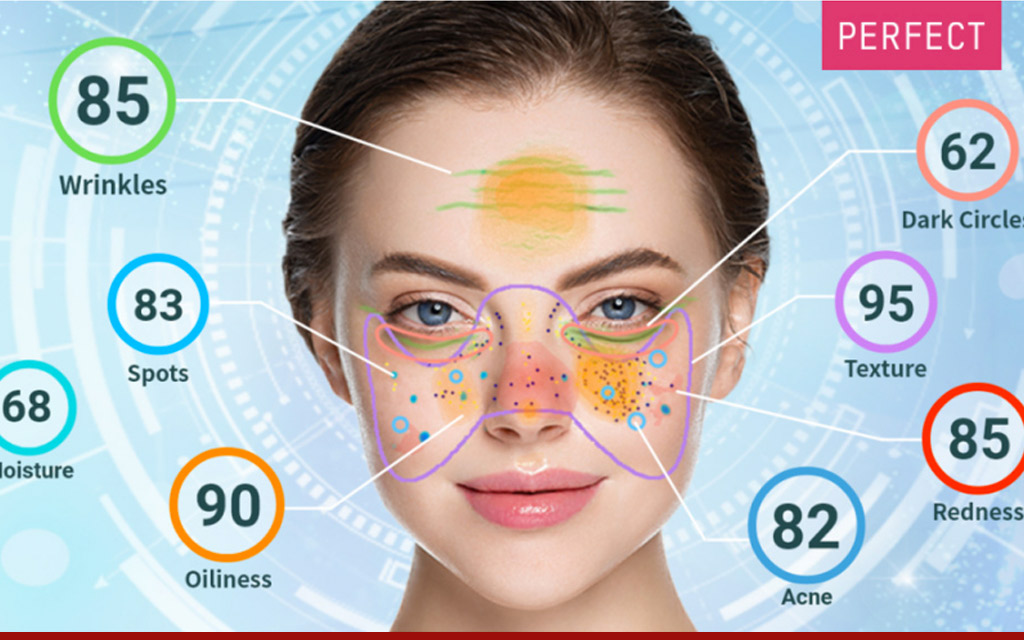Perfect Corporation combines computer imaging, AI, Augmented Reality, and a host of other technologies to provide a solution to beauty in the time of COVID.
Let me take you back to a different time, a mere 6 months ago, when I could while away the hours at the local Sephora–applying foundations, concealers, and lipsticks. Seems like a quaint, distant memory now. Doubtful we’ll go back to smearing-on products touched by others sometime. Meanwhile, we’re witnessing technology reshaping the beauty industry in its own image, turning it more reliant on screens, AI, AR, and personalization. Here are some changes, from the mundane to the sublime, we can expect to linger in the half-trillion-dollar business of cosmetics and personal care products.
Contactless Try-On
Computer imaging, the application of AI datasets, and augmented reality tools were already making their mark on the beauty industry before the pandemic. Companies like Perfect Corp have been at this for years, providing both consumers and businesses with AR solutions that detect your face, image your skin, diagnose problem areas like oiliness, wrinkles, and dark spots, and then provide prescriptive products for you to try on, all without touching a thing.
During the pandemic, companies juggled their algorithms for in-store kiosk use so that they could detect a face wearing a protective mask, for instance, and allow for augmented makeup try-on experiences even in a masked world. And using a combination of gestures and voice activation, you can now try and purchase makeup products without any physical contact with either product or person. One company called Perfect Corp. has a video to demonstrate, that is worth checking out. Expect to see more such augmented experiences. They’ll get more prescriptive as their data sets and image-processing capabilities continue to evolve. Pinterest’s new Try On feature also lets you experiment with your favorite eye-candy to achieve a shoppable moment onscreen.
DIY Beauty
We moved quickly from the toilet paper shortage to the hair dye panic during the first weeks of quarantine. Cutting our own hair, home facials, microdermabrasion — many of the beauty routines that involved a service industry are increasingly available in some do-it-yourself form.
After diagnosing issues about your skin, companies like Duolab and Romy are letting you mix up a personalized batch of face creams. The Hannibal Lecter-looking light-emitting face from MZ Skin ($600) provides the same kind of treatment you might get in a dermatologist’s office. A browse through the Dermstore’s offerings includes micro-needling and other tortures for the DIY crowd. “Don’t try this at home” has far less clout when home is the only alternative.
The Brand of You
The adoption of AI has allowed the beauty industry to create a much more personalized business not bound by shelf space. This helps it create products that better address people according to their ethnicity, gender, and age. Rather than walking into a store where all the products are clumped together, personal assessment tools direct a beauty shopper to an experience of one.
Bio Meets Beauty
The beauty industry always had its share of talented chemists and biologists, but the synthetic creation of new materials is booming, from collagens to injectables. At a recent China Beauty Expo there were predictions for robust investments in skin “microecology” technology, biological fermentation technology and cell extraction. Biodesign and the beauty industry (as evidenced in this video) will be bosom buddies as new materials and ingredients are synthesized.
Sustainability
The blockchain word gets overused as a panacea for all that ails us, but the beauty industry can benefit in a number of ways through tracking and sourcing along its fast-moving supply chain. The net effect could be more sustainable, eco-friendly products. Addressing false claims, better sourcing ingredients and increasing transparency in numerous ways can all be achieved better with a blockchain based infrastructure.
Beauty in a Virtual World
Zoom’s beauty filter gives me the confidence to face my professional life these work-at-home days. As we all spend more time in virtual environments there’s an opportunity for the creation of a world of avatar-enhanced onscreen beauty to take off. L’Oréal USA released augmented beauty lenses for Snap’s desktop app, letting customers virtually try on looks from its brands. Sims 4 teamed up with MAC cosmetics to create beauty looks for in-game avatars. And Instagram is overflowing with creative artists like Jess Herrington , blurring the worlds of in-real-life and virtual beauty with filters and augmentation.
Beauty Meets Health and Wellness
Beauty will continue to blur the lines between skin-deep and overall health and wellness, too. Increasingly we’ll see beauty counters in stores expand their repertoires to include products to help treat the inner self. Obvious entrants are digital therapeutics like stress and anxiety apps delivered via your mobile device, behavioral-change apps, and others that affect personal appearance.
Diet, DNA, and biome assessments will ultimately become an integral part of a deeper approach to beauty, one that radiates from the inside out.
READ MORE: https://techonomy.com/2020/10/the-beauty-industry-bows-to-the-pandemic-beast/




